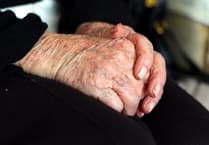While the Battle of the Somme in fact lasted for 142 days, the focus will always remain on the infantry attacks of day one, Saturday, July 1, 1916.
The level of casualties incurred on that day made it the Empire’s blackest day in The Great War. Across the line of the front, from Gommecourt in the north to Maricourt abutting the French sector in the south, British casualties amounted to 19,240 killed and 35,493 wounded.
Of the fallen, nine were Newton Abbot-born and many more were from surrounding communities. Understanding where they fought and fell was the reason that in May, I travelled to two specific areas of the Somme battlefield.
Locally, the majority of casualties on July 1 were from three battalions of the Devonshire Regiments. These were the 2nd Devons who were in action within the 8th Divisions’ attack across Mash Valley to the north of La Bosselle, and the 8th and 9th Devons, fighting within the 7th Division, attacking near Marmetz.
Of the nine fallen Newton men, only one has his name on a headstone, the remainder having No Known Grave are listed on the Thiepval Memorial to the Missing, while possibly lying under an Unknown Soldier headstone within a Commonwealth Wargraves Commission cemetery.
At 7.30am on July 1, 1916, during the last ten minutes of an hour-long artillery bombardment, A and B companies of the 2nd Devons had climbed out of the advance trenches and crawled across No Man’s Land to lie within 100 yards of the German lines. Together with the 2nd Middlesex, they were to lead the attack up Mash Valley in the direction of Pozieres. The battalion’s remaining two companies then replaced them in the front line New Trench.
As the guns stopped these advanced companies dashed to the German trenches only to be caught in a tornado of machine-gun fire on two flanks suffering heavy casualties. Only a handful of the Devons reached the German lines, too few to effect a result, while shell holes of No Man’s Land provided cover for others including many wounded who would work their way back to their own lines as after midday the artillery barrage was brought back on the German lines.
This battalion had suffered 431 casualties in this attack, of which 11 officers and 231 men were killed.
In total 12 Devon-born other ranks lie in the nearby Ovillers Military Cemetery, including Ashburton born Pte William Strawbridge, while Pte William Parker, born in Bovey Tracey, but living in North Bovey, would die of his wounds three weeks later and lies in Longuenesse Cemetery, St Omer.
The Newton born men who fell in this action were Sgt Ernest Hatton, Pte Leo Langwasser, Pte William Lambell, Lce Cpl Frank Osborn, and Pte William Peckins. Pte Beer, whose wife lived at Denbury, would also die of wounds on July 6 and lies at Daours Cemetery Extension, near Amiens.
The 8th and 9th Devons, were the Service Battalions made up of Kitchener Volunteers, and had already fought together at the Battle of Loos. It was the 9th Battalion that was put into the line for the initial attack towards Fricourt at Marmetz, with the 8th Battalion in support. As with all sections of the front the German lines had been under artillery bombardment since June 24, but this had failed to destroy machine-gun positions within Shrine Alley Trench at Marmetz Cemetery. Located under the crucifix Shrine, this would wreak havoc on the advancing battalions of the Devons and Gordon Highlanders as they advanced across the valley below Mansel Copse.
At 7.27am the 9th Devons climbed up the trench ladders as 16 trench mortars laid down covering fire on the German lines. As the leading companies of the 9th entered No Man’s Land they were cut down by rifle and machine-gun fire, especially from the Shrine, 800yds away but by 9am this objective had been taken by the 9th Devons, before they were brought to a standstill.
It was now the time of the 8th Devons to enter the fight. At 10.30am orders to advance reached them, but as the A and B companies passed Mansel Copse they were again caught by intense machine-gun fire and held up until noon when C company were moved forward, with D Company and the Royal Warwickshires securing Marmetz by 6pm.
The 8th Devons had lost three officers and 47 men killed while the 9th fared worst with eight officers and 196 men killed or missing.
It would not be until July 3 that the chaplin of the 8th Devons, Rev Ernest Crosse, would inspect the 163 victims laid out in rows to make sure that his identity tag and personal belongings had been properly stored. The following day he buried them all in the trench below Mansel Copse, having made sure there was a sign painted naming the place as the battalion cemetery – Devonshire Cemetery.
A wooden cross was erected at the entrance to this new cemetery which bore the wording ‘The Devons still hold this trench’. These word would later be transferred to the tablet that sits in its place (see image). The local men who lie here are Pte Frederick French, 9th Devons, and Pte William Gough, 8th Devons.
Gough was a short 30-year-old single man previously employed as a labourer at a local cider company who lived at No.1 Court, Wolborough Street. Sixty-four other Devon-born members of the Devons lie alongside him in the ranks of headstones, including Chudleigh-born Pte Ernest Knight and Pte William Mountford, of Bovey Tracey.
Other Newtonians who fell in this attack are listed at the Thiepval Memorial; Pte John Bearne, 9th was 29 years of age and had been in the employ of Mr Pinsent, of Pinsent Brewery, and Pte William Smith.
It was at Devonshire Cemetery that, together with Bob Cooper, I laid a remembrance wreath on behalf of the Newton Abbot Royal British Legion.
Another Newton-born man would die on this day, this being Lce Cpl A V Brewer, who was one of 51 other ranks who fell in action attacking trenches on the outskirts of Hebuterne, near Gommecourt, with the Queen Victoria Rifles 1st/9th London Regiment. He also is listed on the Thiepval Memorial to the Missing and was 26 years old, having been previously employed by H C Booker and Sons, furniture dealers of Bank Street. His parents lived at Hilton, Keyberry Road.
It would be mid-July before the details of those who fell or were wounded on July 1 would appear in the local press, but these reports would continue to appear for the remainder of the year as the details of some of the 47 men with links to the town of Newton Abbot who fell in the whole length of the Somme campaign were published in the local press.
The rolling, mainly agricultural, countryside of the Somme today gives little indication of the fury of the battles fought there during 1916 if it were not for the large number of Allied and German cemeteries it contains, and the Divisional Memorials erected to mark the dedication and courage of those who fought and fell there.
This article hopefully highlights the courage of the local men who displayed their courage on the black day of July 1, 1916.



